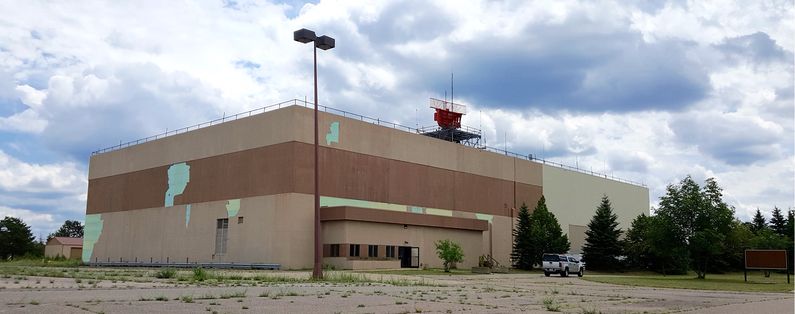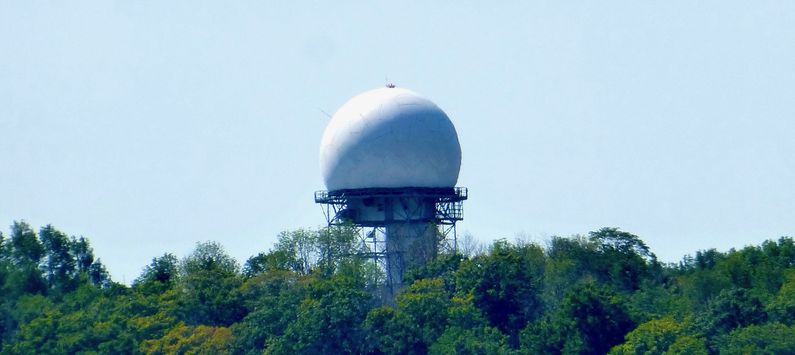Empire Air Force Station
|
Empire Air Force Station (1951-1978) - A Cold War Air Force Radar Station first established in 1951 near Empire, Leelanau County, Michigan. Named Empire Air Force Station after the location. Initially assigned a Permanent ID of P-34, later a Sage ID of Z-34 and a JSS ID of J-58. The Air Force Station was deactivated in 1978 and a small portion of the site was transferred to the Federal Aviation Administration (FAA) and became the Empire FAA Radar Site.
HistoryEstablished in 1951 and became operational in late 1951 as Empire Air Force Station manned by the 752nd AC&W Squadron. The station initially had both a Ground-Control Intercept (GCI) and early warning mission. The early warning mission involved tracking and identifying all aircraft entering their airspace while the GCI mission involved guiding Air Force interceptors to any identified enemy aircraft. Controllers at the station vectored fighter aircraft at the correct course and speed to intercept enemy aircraft using voice commands via ground-to-air radio. Initial equipment included a pair of CPS-6B radars. One of these radars was replaced by a FPS-6 height-finder in 1958. A second FPS-6 height-finder radar was added in 1959. In 1960 the remaining CPS-6B was replaced by a FPS-7 search radar. With the FPS-7 search radar and two FPS-6 height-finders in place the site was prepared to transition into the SAGE System. SAGE System TransitionThe transition of the manual GCI system to the automated SAGE system began with the installation of the FST-2 coordinate data transmitter and search radar upgrades. The FST-2 equipment digitized the radar returns and transmitted the digital returns to the SAGE direction center. Under the SAGE System, interceptor aircraft were directed to their targets by the direction center computers and controllers, greatly reducing the need for local controllers and equipment at every radar station. The FST-2 was a very large digital system using vacuum tube technology. Over 6900 vacuum tubes were used in each FST-2 requiring 21 air-conditioned cabinets, 40 tons of air conditioning, 43.5 kva of prime power, and usually a large new addition to the operations building. The FST-2B modification added two more cabinets but with newer solid-state (transistor) technology to process coded responses from aircraft transponders. SAGE System Operation
The site began operation as a SAGE site in 1960 initially feeding the K.I. Sawyer SAGE Direction Center DC-14. One of the FPS-6 height-finder radars was replaced by a FPS-26A height-finder in 1963. With the closure of the K.I. Sawyer SAGE Direction Center DC-14 in 1963, control was shifted to the Custer SAGE Direction Center DC-06 in July 1963 and in November 1966 shifted again to Duluth SAGE Direction Center DC-10 where it remained until the SAGE System shut down in 1983. In 1964 this site became a USAF/FAA joint-use site. By February 1973 the vacuum tube FST-2 was replaced by a solid-state FYQ-47 Common Digitizer. Gap FillersEmpire AFS was responsible for the maintenance of four remote unattended gap-filler radar sites. The unattended gap filler sites were placed in locations where the main search radar lacked coverage. These sites were equipped with short range FPS-14 or FPS-18 search radars and FST-1 Coordinate Data transmitters that sent digitized radar target data to a SAGE direction center and to the main radar site. Both the radar set and the FST-1 were dual channel to increase site up time. Maintenance teams were dispatched for regularly scheduled maintenance or when fault indicators on the FSW-1 remote monitoring equipment suggested the site had problems. The FSW-1 also allowed remote operation of specific functions such as channel changes for the radar and for the FST-1, it also allowed remote operation of the diesel generators at the gap filler site. The Empire AFS gap-filler radars were located at Petoskey, Shelby, Alpena, and Saugatuck, Michigan.
ClosureThe 752nd Radar Squadron was deactivated on 1 Apr 1978. The FAA assumed control of the operations area except for the height-finders. The USAF part of the radar site operated as Detachment 1 of the 23rd Air Defense Squadron from April 1978 to March 1979 and Operating Location AB, 20th Air Defense Squadron from 1979 until the base closed in 1983. The FPS-6 radar was upgraded to a FPS-116. Empire FAA Radar SiteFAA/USAF joint operations of the Empire site began in 1964. With the deactivation of the 752nd Radar Squadron in 1978, the FAA assumed responsibility for the operations compound except for the height-finder radars. The FAA designation for the site was QJA. In December of 1979, the FPS-7 search radar was replaced by the FAA with an ARSR-3 search radar. In 1983 the SAGE System deactivated and the Empire FAA Radar Site joined the JSS System with a JSS ID of J-58 as one of the original members. The FPS-116 height-finder required the Military Interface Modification (MIM) to connect to the digitizer functionality in the ARSR-3 radar. The modification allowed height-finder operators to process height requests and return height data to USAF direction centers. The FPS-116 was removed about 1988. The ARSR-3 was replaced in Jun 1996 by the current ARSR-4 FAA radar. The FAA now occupies a small compound around the ARSR-4 radar and operates it as a minimally attended radar site. The radar site data is now available to the USAF/NORAD Battle Control System-Fixed (BCS-F) operations centers (EADS & WADS) as well as the FAA Minneapolis ARTCC (ZMP) and adjacent ARTCCs. Other federal agencies have access to the data under the Homeland Security umbrella. Physical PlantThe physical plant of the site was divided into the main site, a cantonment area, a housing area, and a radio site. The main site housed the operations buildings, the radar towers, and the backup generators. The cantonment area housed the enlisted barracks, the bachelor officer's quarters, the orderly room, the dining hall, the motor pool, and other support buildings. Apart from the main site was a small nine-unit housing area for married personnel. A separate radio site housed the radio equipment for directing aircraft intercepts. Like most early radar stations, Empire originally had a radio transmitter site and a separate radio receiver site used by local controllers for voice direction of fighter interceptors to their targets. With the SAGE System, the SAGE Direction centers had the primary task of directing intercepts and the local radio sites were reconfigured, usually into a single site that was known as the Ground to Air Transmitter Receiver (GATR) site. The GATR site communicated with the interceptors from either the local site or the SAGE direction center via voice commands and/or a digital data link.
Current StatusPart of the old radar station is now an active FAA radar site. The remainder was abandoned to the U.S. Forest Service and is now part of the Sleeping Bear Dunes National Lakeshore. A museum in Empire has a full history of the air station, including a historical marker and the original rock marker for the Dining Hall on display.
See Also:
Sources:
Links:
Visited: Area 24 Aug 2013
| ||||||||||||||||||||||||||||||||||||||||||||||||||||||||||||||||||||||||||||||||||||||||||||||||
